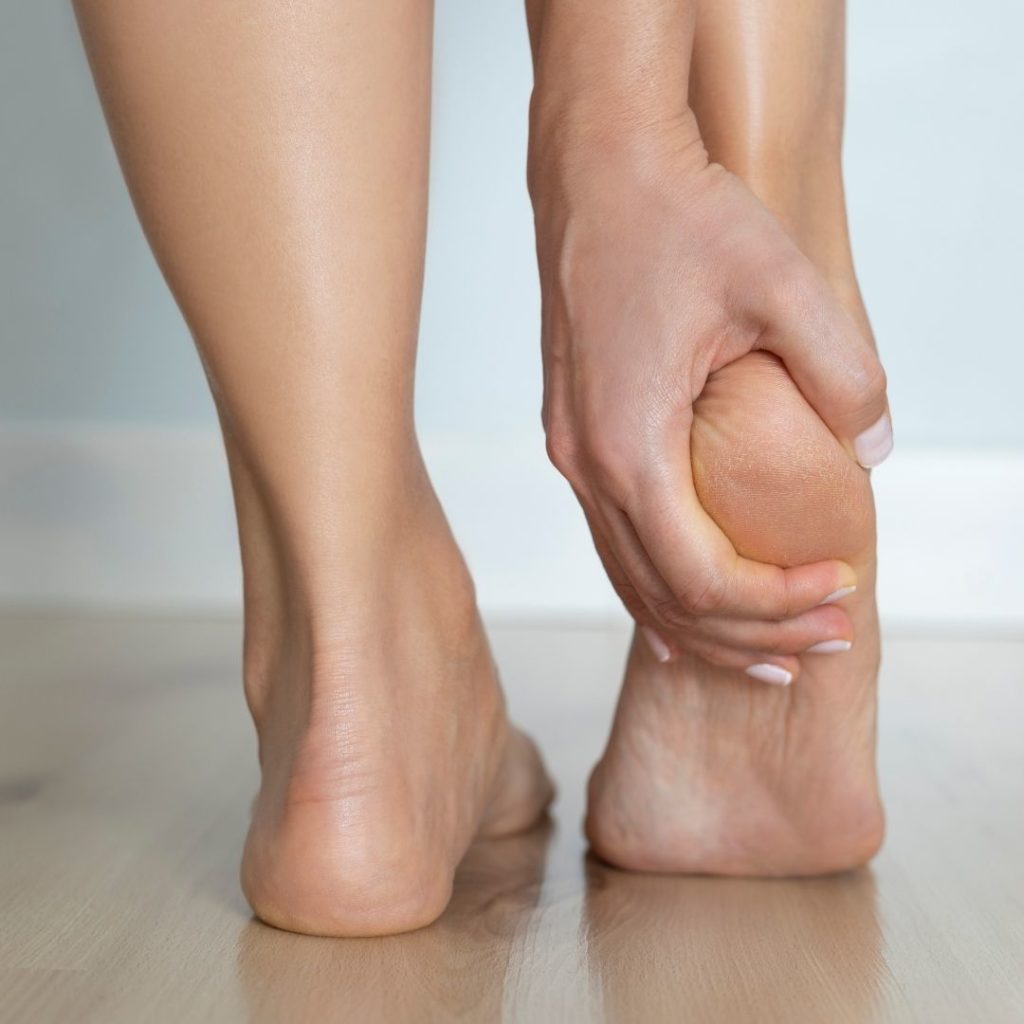What to Do for Plantar Fasciitis Heel Pain
Plantar Fasciitis
causes, symptoms, treatments, and other resources
Your heel pain initially was mild and aching. Information technology is now a constant forest fire at the base of your heel. Each morning time you take your first pace with great trepidation knowing that the searing pain is literally a step abroad. Medications, rest, and concrete therapy have not helped. Your medico is concerned and thinks yous may have Plantar Fasciitis. What is Plantar Fasciitis? What are the symptoms of Plantar Fasciitis? What are the take chances factors? Is Plantar Fasciitis simply inflammation? What are the treatment options for Plantar Fasciitis? What to do for Plantar Fasciitis so bad I tin can't walk? Beware every bit non all heel hurting is Plantar Fasciitis. Meet PR.
What Is Plantar Fasciitis?
Plantar Fasciitis is a painful status that affects the connective tissue that attaches to the base of operations of your heel and foot. The Plantar Fascia is a thick band of connective tissue that extends from your heel os to your toes. The Plantar Fascia has three bands: Medial, Fundamental, and Lateral. It functions to back up and protect the foot (1). Plantar Fasciitis is i of the near common causes of heel hurting and is estimated to bear on 2 million people annually in the United States (ii). The prevalence is lowest in those aged xviii-44 and highest in those aged 45-64 years of age. It tin affect both sedentary and athletic individuals akin.

What Are the Symptoms of Plantar Fasciitis?
Plantar Fasciitis develops in stages. It typically begins with slight discomfort in your heel or arch. The mild intermittent hurting tin can progress to a constant and debilitating nightmare. The nigh common symptoms include:
- Heel Pain (typically 1 sided: left or right)
- Arch Pain
- Morning Pain: That outset step out of bed tin have your jiff away. It typically gets better equally the day progresses
- Achilles Tendon Tenderness and Hurting
- Tight Calves
- Difficulty Walking Due to Pain
Causes & Risk Factors for Plantar Fasciitis
Adventure factors for Plantar Fasciitis tin can be grouped into three major categories: anatomical, mechanical, and ecology (three).
Anatomical Factors
- Obesity
- Flat Feet
- Very high arched feet
- Shortened Achilles Tendon
Mechanical Factors
- Overpronation ( inward rotation)
- Express ankle movement
- Weak foot muscles
Environmental Factors
- Leg length disproportion
- Deconditioning
- Prolonged standing
- Poor footwear
- Poor biomechanics
Is Plantar Fasciitis a Simple Example of Inflammation?
No. The term Plantar Fasciitis is misleading as the "itis" would atomic number 82 the reader to suspect an inflammatory process. For instance, Bursitis is the inflammation of a Bursa which can be a painful status. A Bursa is a fluid-filled sac that promotes frictionless sliding of tendons, muscles, and ligaments over boney areas in the trunk. There are many in the foot and ankle.
Plantar Fasciitis is Non a simple inflammation of the Plantar Fascia. Rather it is a chronic degeneration and micro-tearing of the Plantar Fascia (4).
Treatment Options for Plantar Fasciitis
Handling options for plantar fasciitis depend upon the severity of the condition and resources bachelor in your customs. When appropriate conservative care should always be the first line of treatment.
Conservative Care
Residuum, safe anti-inflammatory medications such equally Turmeric and Fish oil, stretching, summit, advisable shoes, night splint, orthotics, physical therapy are examples of conservative, first-line treatment options.
Steroid Injections
Steroids are oft recommended when bourgeois care fails to provide significant benefits. Steroids are powerful anti-inflammatory agents only are as well known to cause tissue damage including cartilage damage and tendon rupture (5).
Surgery
When bourgeois care and steroids have failed many patients are referred for surgery. The nigh common surgery is Partial Plantar Fasciotomy which involves cut a portion of the Plantar Fascia. Intuitively this makes piddling sense every bit the underlying problem is degeneration and micro-trigger-happy. Cutting a portion of the diseased Plantar Fascia out will not address the underlying degeneration of Fascia. Rather it will weaken an already compromised structure which tin can give rise to hurting and dysfunction.
PRP
Platelet-rich plasma is a powerful handling choice every bit it is rich in growth factors that can increase blood flow and decrease inflammation. It is a simple process where blood is extracted from your arm, processed to concentrate the platelets, and then injected into the area of damage within the Plantar Fascia. Ultrasound is required to ensure proper placement of the PRP. Bullheaded injections are below the standard of care of the Centeno-Schultz Clinic and should be avoided. In multiple studies, PRP has been not but effective in the handling of Plantar Fasciitis but is besides superior to steroids (six).
Non All Heel Pain is Plantar Fasciitis
Not all heel pain is from Plantar Fasciitis. Establishing a correct diagnosis is critical and then that an appropriate treatment plan can be developed. This is the cornerstone at the Centeno-Schultz Clinics in Broomfield and southward Denver. The wrong diagnosis and prescribed treatments tin can lead to harmful outcomes equally illustrated in a current clinic patient.
Encounter PR
PR is a 65-twelvemonth-old Existent Manor professional person who presented to the clinic with a 5-year history of heel hurting that was progressive in nature localized on both heels, left greater than right. The pain was burning in character and oft times awakened her at night. Onset was non associated with whatsoever trauma. Treatment to date had included rest, NSAIDs, stretching, and massage. She has been given the diagnosis of Plantar Fasciitis. Her Plantar Fasciitis was so bad that she could not walk at times. This complicated her job and her ability to care for her elderly mother. My discussion with PR included these questions:
How was the diagnosis of Plantar Fasciitis made? The physician simply told me that is what I had.
What imaging studies were performed?None
Was an ultrasound test performed confirming the diagnosis of Plantar Fasciitis? No
Was a thorough exam performed including examination of your low back and nerves?No
What were the treatment recommendations?Surgery in 2 weeks and walking boot for thirty days thereafter.
PR disclosed that she had a longstanding history of low back pain and an episode of severe left Sciatica last year. Her examination revealed tenderness in her low back, limited movement, and decreased awareness and strength in her left toes. Ten-ray of her depression back demonstrated astringent disc injury characterized by the reduced height of the lowest disc. Ultrasound of her heel and Plantar Fascia was normal. Surgery would not have helped her. PR did non have Plantar Fasciitis merely rather an irritated nerve in her low back due to her disc injury. PR underwent a diagnostic injection of numbing medication and a depression-dose steroid. Shortly thereafter all her debilitating heel pain was gone. She had tears of joy. After this month she will return for a Platelet Epidural injection.
To learn more about PRP injections as an culling to back surgery and epidural steroid injections please click on the video beneath. https://www.youtube.com/embed/kICFiT9DsTg?characteristic=oembed
Other Causes of Heel Pain
Every bit illustrated above non all heel pain arises from Plantar Fasciitis. Other causes of heel pain include:
- Tibial nerve entrapment or pinch (Tarsal Tunnel Syndrome)
- Neuropathy from underlying medical atmospheric condition such as diabetes
- Human foot arthritis
- Heel fracture
- Achilles Tendinitis
- Posterior Tibial Tendonitis
- Low dorsum nerve irritation secondary to disc injury, vertebral body slippage or stenosis
- Bursitis
- Heel spur
- Os Infection (Osteomyelitis)
In Determination
- Plantar Fasciitis is a painful status that affects the connective tissue that attaches to the base of your heel and pes.
- Plantar Fasciitis is i of the most common causes of heel pain
- Symptoms of Plantar Fasciitis include: Heel pain, curvation pain, forenoon hurting, Achilles tendon tenderness or pain, and difficulty walking.
- Risk factors for Plantar Fasciitis can be grouped into three major caetgories: anatomical, mechanical and ecology.
- Plantar Fasciitis is not a simple case of inflammation but rather is a chronic degenerative process that requires your attending.
- Treatment options include bourgeois care, steroid injections, surgery and PRP.
- Non all heel pain is due to Plantar Fasciitis.
- PR is a patient who was diagnosed with Plantar Fasciitis then bad that she could non walk. She was scheduled for surgery. She had the wrong diagnosis as her heel pain was due to an irritated nervus in her low back.
- There are multiple causes of heel pain that include nerve entrapment, pes arthritis, fracture, tendonitis, bursitis, depression back nerve irritation and infection.
If you or a loved one have ongoing heel hurting, or "Plantar Fasciitis so bad I tin can't walk" that has non responded to conservative treatment, delight schedule a telephone candidacy discussion with a board-certified, fellowship-trained physician. At the Centeno-Schultz Clinic, nosotros are experts in the evaluation and treatment of pes and heel injuries. From the comfort of your domicile or part learn what treatment options are bachelor for y'all.
Empty Spacer
Our Doctors Who Treat Plantar Fasciitis

Christopher J. Centeno, MD
Christopher J. Centeno, M.D. is an international expert and specialist in Interventional Orthopedics and the clinical use of bone marrow concentrate in orthopedics. He is board-certified in physical medicine and rehabilitation with a subspecialty of hurting medicine through The American Board of Concrete Medicine and Rehabilitation. Dr. Centeno is one of the few physicians in the world with extensive experience in the civilisation expansion of and clinical use of adult bone marrow concentrate to treat orthopedic injuries. His clinic incorporates a variety of revolutionary pain management techniques to bring its wide patient base relief and results. Dr. Centeno treats patients from all over the The states who…
Read more

John Schultz, Physician
My passion and specialization are in the evaluation and treatment of cervical disc, facet, ligament and nerve pain, including the non-surgical treatment of Craniocervical instability (CCI). I quit a successful career in anesthesia and traditional pain management to pursue and accelerate the employ of PRP and bone marrow concentrate for mutual orthopedic conditions. I take been a patient with astringent pain and know firsthand the limitations of traditional orthopedic surgery. I am a co-founder of the Centeno-Schultz Clinic which was established in 2005. Being active is a key function of my life as I enjoy time skiing, biking, hiking, sailing with my family and nine grandchildren.
Read more

John Pitts, M.D.
Dr. Pitts is originally from Chicago, IL just is a medical graduate of Vanderbilt School of Medicine in Nashville, TN. Later on Vanderbilt, he completed a residency in Physical Medicine and Rehabilitation (PM&R) at Emory University in Atlanta, GA. The focus of PM&R is the restoration of function and quality of life. In residency, he gained much feel in musculoskeletal medicine, rehabilitation, spine, and sports medicine forth with some regenerative medicine. He also gained significant experience in fluoroscopically guided spinal procedures and peripheral injections. Withal, Dr. Pitts wanted to broaden his skills and treatment options beyond the current typical standards of intendance.
Read more

Jason Markle, D.O.
Post-residency, Dr. Markle was selected to the Interventional Orthopedic Fellowship program at the Centeno-Schultz Dispensary. During his fellowship, he gained pregnant feel in the new field of Interventional Orthopedics and regenerative medicine, honing his skills in advanced injection techniques into the spine and joints treating patients with autologous, bone marrow concentrate and platelet solutions. Dr. Markle then accepted a full-time attending physician position at the Centeno-Schultz Clinic, where he both treats patients and trains Interventional Orthopedics fellows. Dr. Markle is an active member of the Interventional Orthopedic Foundation and serves every bit a grade instructor, where he trains physicians from effectually the earth.
Read more than

Matthew William Hyzy, D.O.
Doctor Hyzy is Board Certified in Physical Medicine and Rehabilitation (Physiatry) and fellowship-trained in Interventional Orthopedics and Spine. Dr. Hyzy is also clinical faculty at the University of Colorado School of Medicine in the Section of Physical Medicine and Rehabilitation; In addition, Dr. Hyzy is an Adjunct Clinical Assistant Professor at The Rocky Vista Academy Higher of Osteopathic Medicine. Dr. Hyzy as well maintains an active infirmary-based practice at Swedish Medical Center and Sky Ridge Medical Center. He is also recognized and qualified equally an expert physician witness for medical-legal cases and Life Care Planning. He is published in the utilize of autologous solutions including…
Read more than

Brandon T. Money, D.O., M.S.
Dr. Money is an Indiana native who now proudly calls Colorado abode. He attended medical school at Kansas City University and and then returned to Indiana to complete a Physical Medicine and Rehabilitation residency program at Indiana Academy, where he was trained on not-surgical methods to better health and function also every bit rehabilitative care post-obit trauma, stroke, spinal cord injury, brain injury, etc. Dr. Coin has been following the ideology behind Centeno-Schultz Clinic and Regenexx since he was in medical school, as he believed there had to be a better way to intendance for patients than the status quo. The homo torso has incredible healing capabilities…
Read more

Mairin Jerome, MD
Dr. Mairin Jerome is a physiatrist with subspecialty fellowship training in Interventional Orthopedics and Regenerative Medicine. This subspecialty serves to fill the gap for patients who are interested in therapeutic options that lie between conservative treatment and surgery. Dr. Jerome uses regenerative medicine techniques, including prolotherapy and orthobiologics, via X-ray or ultrasound guidance to precisely deliver injections to areas of musculoskeletal injury or degeneration. Orthobiologics refers to tissue harvested typically from a person's own body, such as platelets (platelet-rich plasma, PRP) or bone marrow, for use in treating painful musculoskeletal weather. The goal is to stimulate the body's healing mechanisms to improve hurting, function, and decrease inflammation.
Read more than
More than Resources for Plantar Fasciits
-
Stem Cell Treatment for Foot Pain: Larn the Truth.
Pes hurting tin can be debilitating. Dr. Schultz discusses the 7 major causes of foot hurting, traditional handling options, stem jail cell treatment options, the unlike types of stem cells, factors that will influence the specific stem jail cell handling plan, and the advantages of stem cells over steroids and surgery.
-
Tibial Nerve Injury: Symptoms, Diagnosis, and Treatment Options
Dr. Markle discusses tibial nerve injury – what that ways, when yous demand surgery, and how to avoid surgery. Transcript: Introduction Hello, Dr. Markle of Centeno-Schultz Dispensary, and today nosotros're going to be talking nearly how to treat tibial nervus injury. We'll be discussing exactly what is the tibial nerve, the muscles the tibial innervates, … Connected
-
Morton's Toe & Morton's Neuroma: What Are They, and What Treatments Are Available?
Morton's Toe vs. Morton's Neuroma – A small course on what they are and what can be done to treat them. Transcript Dr. John Schultz Howdy, everybody. This is Dr. Schultz with the Centeno-Schultz Dispensary. I idea we'd accept a little fun today. Y'all know, summer's here and nosotros're having fun. Some of us are … Continued
-
3 Things to Know Near Navicular Bone Pain
Foot pain can be crippling. Where is Navicular Bone? Why Does my Navicular Os Hurt? How exercise you treat Navicular bone pain? Let's dig in. Where is Navicular Bone? There are 26 bones in the foot. The Navicular Bone is a minor C-shaped os located on the inside portion of the midfoot. It is nestled … Connected
-
PRP for Plantar Fasciitis
Dr. Pitts discusses PRP for Plantar Fasciitis, how information technology compares to steroid injections, and iii studies of PRP. Transcript Hello everybody, this is Dr. John Pitts from the Centeno-Schultz Clinic. Today, I'd like to talk virtually PRP for plantar fasciitis. Then, in short: yes, PRP can be used for plantar fasciitis. But let's talk about … Connected
-
Life After Talonavicular Fusion: What Do You Know Near this Surgery?
Ankle pain can be excruciating ofttimes times making a simple pace nearly impossible. What is a Talonavicular fusion? What are the indications for a Talonavicular fusion? What are the complications from a Talonavicular fusion? What does life look like after talonavicular fusion? Let'south dig in. Foot Anatomy The foot is compromised of 26 bones. The … Connected
one.Kim W, Voloshin AS. Office of plantar fascia in the load bearing capacity of the human foot. J Biomech. 1995 Sep;28(9):1025-33. doi: ten.1016/0021-9290(94)00163-x. PMID: 7559672.
ii.Schwartz EN, Su J. Plantar fasciitis: a concise review. Perm J. 2014;xviii(one):e105-e107. doi:10.7812/TPP/13-113
3.Dyck DD Jr, Boyajian-O'Neill LA. Plantar fasciitis. Clin J Sport Med. 2004 Sep;fourteen(5):305-9. doi: x.1097/00042752-200409000-00010. PMID: 15377971.
iv.Thomas JL, Christensen JC, Kravitz SR, Mendicino RW, Schuberth JM, Vanore JV, Weil LS Sr, Zlotoff HJ, Bouché R, Baker J; American College of Pes and Ankle Surgeons heel pain committee. The diagnosis and handling of heel pain: a clinical practice guideline-revision 2010. J Foot Ankle Surg. 2010 May-Jun;49(3 Suppl):S1-19. doi: 10.1053/j.jfas.2010.01.001. PMID: 20439021.
five. Wernecke C, Braun HJ, Dragoo JL. The Effect of Intra-articular Corticosteroids on Articular Cartilage: A Systematic Review. Orthop J Sports Med. 2015;three(5):2325967115581163. Published 2015 April 27. doi:10.1177/2325967115581163
vi.Hurley ET, Shimozono Y, Hannon CP, Smyth NA, Murawski CD, Kennedy JG. Platelet-Rich Plasma Versus Corticosteroids for Plantar Fasciitis: A Systematic Review of Randomized Controlled Trials. Orthop J Sports Med. 2020;eight(4):2325967120915704. Published 2020 Apr 27. doi:x.1177/2325967120915704
Source: https://centenoschultz.com/condition/plantar-fasciitis/
0 Response to "What to Do for Plantar Fasciitis Heel Pain"
Post a Comment